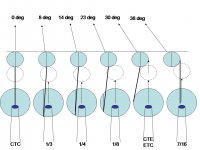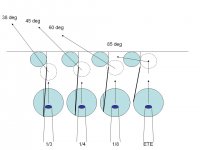Good question perhaps for CJ if he concurs with the diagram.
As for me, If the center of the CB is aimed at the center of the OB (CTC) that aim line yields a straight in shot.
If one aims the edge of the CB at the center of the OB and hits the center of the CB parallel to the ETC line, it will effect the center of the CB being aimed at the edge of the OB or CTE and yields a 30 degree cut angle shot.
It then follows that the fractions between the edge of the CB and it's center will yield those angles in between...as I diagrammed it.
Good question perhaps for CJ if he concurs with the diagram.
As for me, If the center of the CB is aimed at the center of the OB (CTC) that aim line yields a straight in shot.
If one aims the edge of the CB at the center of the OB and hits the center of the CB parallel to the ETC line, it will effect the center of the CB being aimed at the edge of the OB or CTE and yields a 30 degree cut angle shot.
It then follows that the fractions between the edge of the CB and it's center will yield those angles in between...as I diagrammed it.
I think the main breakdown for those who don't get CTE is the inability to understand perspective and illusions. For example, with your comment:
"aiming the edge of the CB to the center of the OB and hits the center of the CB parallel to the ETC line yields a 30 degree shot"
That comment is really a 2 dimensional description that's quite true, but it doesn't apply to the reality of pool. It's hard to imagine aiming with fractions by using a parallax line to the direction of your vision.
Let me explain:
People often think that sighting down the CTEL (top image) yields the same angle as the ETC line when it definitely doesn't. On a pool table diagram, they're equivalent. In the real world, the two are very different.
For example, the top image is similar to what one would see sighting "down" the CTEL. Obviously, the bottom is sighting "down" the ETC line. I made a small blue line to illustrate the CTEL, just for a reference. That would give you an idea to what line you're really paralleling down, based on your description. As you can see, you'd never get there as a player - you'd be shooting across your field of vision.
People tend to build the foundation of their math based on vertical lines in their field of vision (the light blue line to the left, showing the "ETC" decision) as if they're playing on a 2D diagram. For example, once you sight down the light blue line, if you were to flip your eyes down to the CB and strike center ball, you might miss the OB completely based on the distance. In fact, you will miss the OB at some point.
We're surrounded by a world of perspective illusions and it's those illusions, I believe, that make CTE work. For example, if you were to stand in the middle of a railroad track (centered between both rails) and look straight down the track, the rails will converge at one point. I tried to illustrate that to some point with the dark blue lines off the CB. Decision making is based on 2D references (i.e. something similar to the light blue line) but reality is a world of converging points based on distance. People have to fight (or use) the same illusion found on a railroad track on a pool table, it's just a lot more subtle.
I'm too lazy to make a second picture, but if I weren't, it would show that one's eyes must offset more in order to keep an ETE line "straight" in their field of vision. The OB gets smaller and the lines converge.
Looking at your diagram, the CTE/ETC and the ETE diagrams don't illustrate how a player identifies an alignment. They're correct, definitely, but not used in practice.
That said, the light blue line that's used to identify alignments isn't geometrically correct. However, it's "incorrectness" changes at a constant rate, likely figured on perspective calculations and the required eye placement to perceive such.
I just caught myself writing a book, shit. In summary, the answer to your concern with CTE is answered with two words: eye placement. Your eyes must move to maintain relationships based on distance. For shots of equal distance and different angles (but falling within the same visual), your eyes must move again to the "outermost" or "innermost" point to face the general direction of the pocket or fade the pocket, depending on the cut angle.
In summary, use the illusions -- they're required for CTE. It's all perspective-based. Eye placement is everything. Stan calls it "visual intelligence" - Gene calls it "Perfect Aim - move your eyes til you lose the shot and then come back a hair" - Hal used to say "see the outermost edge." All of these guys, in my humble opinion, stumbled upon the exact same thing with eye placement --- what seems incorrect, is correct. What seems right, isn't.
That's why people play their whole lives and can't make a ball. It's also why people who first report using CTE say, "There's NO way this goes" and then the ball goes center hole like magic.


